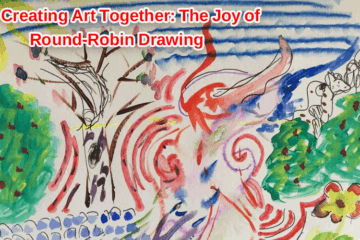Exploring the world of art with young minds is a delightful journey that constantly seeks innovative approaches to creativity. Fruit and vegetable stamps, an age-old technique, offer a unique and engaging way for kids to blend the natural textures of produce with their artistic expressions. This hands-on activity not only introduces children to the joys of painting but also connects them with the beauty and diversity of the natural world.
Step by Step: Creating Fruit and Vegetable Stamp Art:
1. Selecting the Stars: Begin the artistic adventure by choosing an array of fruits and vegetables that intrigue the imagination. Apples, potatoes, bell peppers, and celery are excellent choices due to their distinct textures and cut surfaces.
2. Preparing the Canvas: Lay out the canvas or paper where the magic will unfold. To protect clothes from accidental paint splatters, it’s advisable for kids to don an apron or wear old clothes.
3. Applying the Paint: Pour a small amount of paint onto a palette or plate. Young artists can then either use a brush to paint a thin layer onto the cut surface of the chosen fruit or vegetable or dip it directly into the paint.
4. Stamp and Reveal: Gently press the painted fruit or vegetable onto the canvas or paper, allowing the texture to transfer its unique pattern. The anticipation builds as the stamp is lifted, unveiling a wonderful imprint.
5. Embrace Patterns and Colors: Encourage kids to unleash their imagination by experimenting with various fruit and vegetable stamps. The result can be a symphony of repeating patterns, whimsical designs, or even the formation of captivating images by combining stamps.
6. Manage Excess Paint: Before diving into the next stamp, it’s a good idea to blot the fruit or vegetable on a paper towel. This step prevents colors from blending excessively and maintains the integrity of each imprint.
7. A Touch of Detail (Optional): Once the stamped designs have dried, children can amplify their artwork by using brushes to add intricate details, outlines, or additional hues to the stamped imprints.
8. Proud Display: After the artwork has fully dried, the masterpiece is ready for display. The union of nature’s textures and children’s creativity creates a visually captivating piece that speaks to their artistic journey.
The Essence of Fruit and Vegetable Stamps:
Fruit and vegetable stamp art encapsulates more than just painting. It’s an experience that nurtures a deep connection between children and the world around them. This creative endeavor introduces young minds to textures, patterns, and colors inherent in various fruits and vegetables, while also fostering an appreciation for the diversity of nature’s offerings.
The technique allows children to explore the captivating interplay of textures, experiment with color combinations, and embrace the unexpected beauty that emerges when nature and art collide. Furthermore, the process enhances their fine motor skills, hand-eye coordination, and spatial awareness, all while sparking their innate curiosity.
Conclusion:
Nature’s imprints through fruit and vegetable stamps are a magical invitation for kids to explore their creativity in a tangible and tactile manner. As they engage in this age-old technique, they’re not just creating art; they’re cultivating a profound connection with the natural world. With each stamp, they embark on a journey of discovery, where vibrant colors, intricate textures, and imaginative patterns come together.





